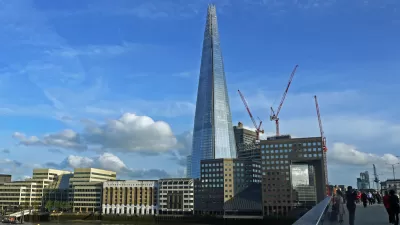For Ken Greenberg, it's clear Toronto is "going through a metamorphosis of extraordinary proportions," comparable to the development of New York in the mid-20th century. He examines how the city must prepare for an unprecedented scale of development.
Greenberg takes the recent debates over a proposal for a massive new project by architect Frank Gehry destined for the city's theatre district as just the recent indication that, "[l]ike it or not, Toronto is becoming a different city. It's now clear," says Greenberg,
"that we're transitioning to a city with a vastly different level of
intensity."
So what will be required to maintain a high quality-of-life in this transformed city? Toronto must confront its "infrastructure deficit" he argues. "We have failed to
make the investments in public transit that are urgently needed. Our
narrow sidewalks and poorly designed streets are already jammed. We will
need to invest in public services to accommodate the major increases in
population. Our public spaces are meagre and poorly equipped and
maintained."
Clearly, says Greenberg, the city must have a public conversation about the cumulative impacts of the massive projects transforming the city. And why not start with the project designed by hometown hero Frank Gehry, which has already engendered much debate?
"The extreme makeover of the King Street West entertainment strip may be
the pretext or catalyst for exactly the kind of public conversation
Toronto needs to have about the future of our city and its downtown."
FULL STORY: Extreme makeover: Toronto’s density challenges

Study: Maui’s Plan to Convert Vacation Rentals to Long-Term Housing Could Cause Nearly $1 Billion Economic Loss
The plan would reduce visitor accommodation by 25,% resulting in 1,900 jobs lost.

Placekeeping: Setting a New Precedent for City Planners
How a preservation-based approach to redevelopment and urban design can prevent displacement and honor legacy communities.

Using Old Oil and Gas Wells for Green Energy Storage
Penn State researchers have found that repurposing abandoned oil and gas wells for geothermal-assisted compressed-air energy storage can boost efficiency, reduce environmental risks, and support clean energy and job transitions.

Washington State Plans Ambitious ‘Cycle Highway’ Network
The state is directing funding to close gaps in its existing bike network and make long-distance trips more accessible.

Homeowners Blame PG&E for Delays in ADU Permits
The utility says it has dramatically reduced its backlog, but applicants say they still face months-long delays for approvals for new electrical work.

Rethinking Wildfire Defense: How a Landscape Approach Can Protect Neighborhoods
Post-fire analysis of the Eaton Fire reveals that a landscape approach — including fire-resistant vegetation, home hardening, and strategic planning — can help reduce wildfire risk, challenging assumptions that trees and plants are primary fire hazards.
Urban Design for Planners 1: Software Tools
This six-course series explores essential urban design concepts using open source software and equips planners with the tools they need to participate fully in the urban design process.
Planning for Universal Design
Learn the tools for implementing Universal Design in planning regulations.
Borough of Carlisle
Caltrans
Heyer Gruel & Associates PA
Institute for Housing and Urban Development Studies (IHS)
City of Grandview
Harvard GSD Executive Education
Salt Lake City
NYU Wagner Graduate School of Public Service
City of Cambridge, Maryland




























